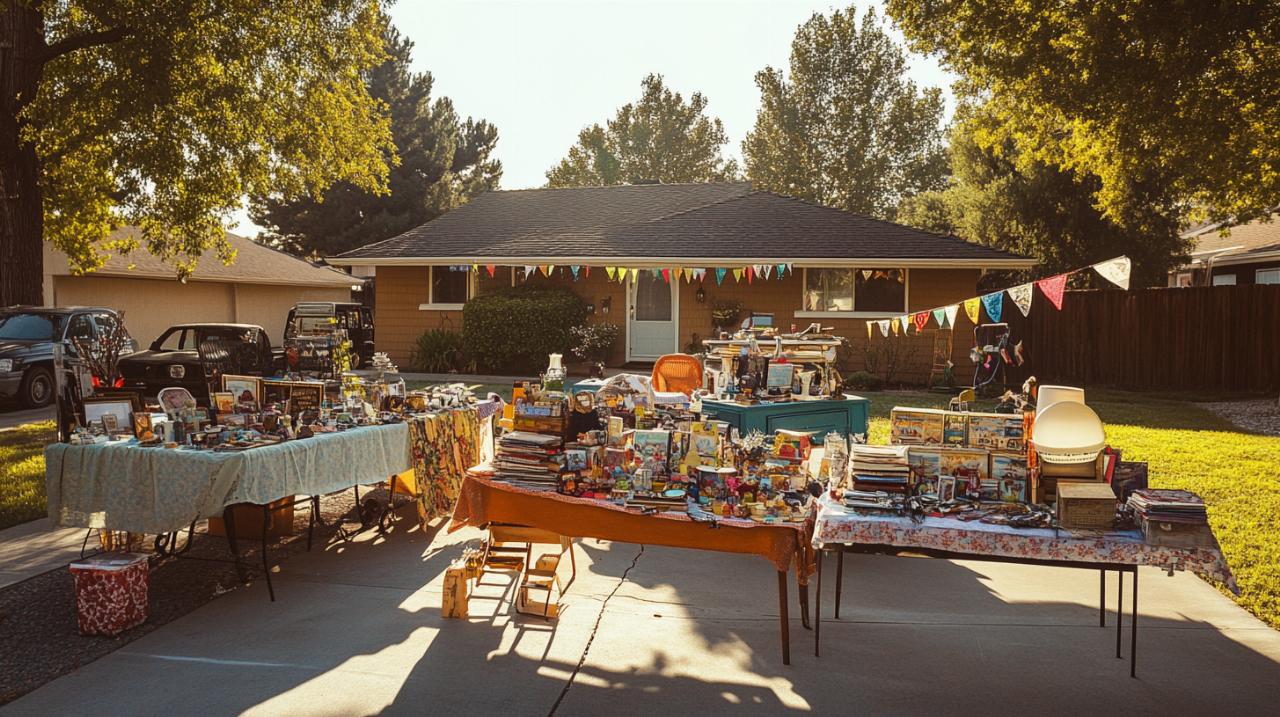Hosting a garage sale at your home can be a brilliant way to shift unwanted clutter, earn a bit of extra cash, and prepare for major life changes such as a house move. Whether you're hoping to raise funds for a holiday, lighten your load before relocating, or simply clear out belongings you haven't touched in yonks, the key to success lies in careful planning, smart pricing, and creating an inviting atmosphere for potential buyers. With the right approach, your sale can attract plenty of shoppers eager to snap up bargains whilst you pocket a tidy sum.
Preparing your items and pricing strategy
Sorting and Selecting What to Sell
The first step in organising a successful garage sale is deciding exactly what you want to flog. Take time to sort through your belongings and set aside items that you genuinely no longer need or use. This might include kitchen appliances, audio equipment, baby gear in good nick, books, houseware, toys, games, bikes, lamps, mirrors, pictures, gardening tools, musical instruments, plants, rugs, and sports equipment. Focus on quality over quantity: ensure that everything you plan to sell is clean, presentable, and in good working order. Shoppers are far more likely to purchase items that look well cared for and ready to use straight away. A thorough clear-out not only maximises your potential earnings but also reduces the number of belongings you'll need to move or store if you're relocating. Remember to make a comprehensive list of everything you intend to sell, including larger pieces such as furniture, so you can keep track of your inventory and pricing decisions.
Setting fair and attractive prices
Pricing your items correctly is essential to ensuring they sell quickly whilst still netting you a decent return. As a general rule, used items in good condition can typically be priced at around twenty per cent of their original retail value. For instance, books might go for one to three pounds, DVDs and CDs for one to two pounds, adult clothing for three to five pounds, children's clothing for one to three pounds, small kitchen appliances for five to fifteen pounds, and furniture for seventy to eighty per cent off the retail price. It's wise to check local listings and online marketplaces to gauge what similar items are fetching in your area. Make sure every item is clearly tagged with a price to avoid confusion and speed up transactions. Consider grouping similar items together with a single price sign, such as all kids' clothes for a pound each, to simplify the shopping experience. Build a little room into your pricing to allow for negotiation, as many buyers will expect to haggle a bit, but don't be tempted to price things too high or you risk putting off potential customers. Having a float of around one hundred pounds in small denominations ready for making change will keep transactions running smoothly throughout the day.
Marketing your garage sale effectively
Creating eye-catching posters and signage
Good signage is absolutely crucial to drawing in foot traffic and ensuring your sale doesn't go unnoticed. Create bold, colourful posters that are easily readable from about thirty feet away, featuring large arrows to direct people to your location. Include essential details such as the date, start and finish times, and your address. Posting signs the night before the sale can help build anticipation and give early birds a chance to plan their route. Place signs at key junctions and busy roads near your home to capture passing motorists and pedestrians. If your location isn't ideal for attracting shoppers, consider teaming up with a neighbour who has a better spot or clubbing together with friends to create a larger, multi-household event that will naturally draw more visitors. Bright balloons tied to your signs or mailbox can also catch the eye and signal that your sale is underway.
Leveraging social media to reach local buyers
In today's digital age, online promotion is far more effective than traditional classified ads. Use Facebook Marketplace, local community groups, Craigslist, and neighbourhood apps to advertise your garage sale well in advance. Include clear photos of some of your best items, the address, date, time, and a brief description of what you're selling. Engaging with local buyers online allows you to build buzz and even field enquiries ahead of time. Some shoppers appreciate being able to ask questions or reserve certain items before the sale officially begins. Spreading the word through your social media channels and encouraging friends and family to share your posts can significantly increase the number of people who show up on the day. If you visit shopline blog or similar platforms, you'll find additional tips on marketing strategies that can help you reach a wider audience and maximise attendance at your sale.
Creating an appealing display
Organising your stall for maximum impact
Presentation truly is key when it comes to enticing shoppers to browse and buy. Arrange your items neatly on tables, shelves, or blankets spread on the ground, grouping similar products together so that buyers can easily find what they're looking for. For example, cluster all kitchen items in one area, children's toys in another, and clothing sorted by size or type elsewhere. Position your more expensive or eye-catching items closer to your garage or entrance to draw people in and encourage them to explore further. A well-organised display not only looks more professional but also helps shoppers navigate your sale quickly and efficiently. Make sure there's enough space for people to move around comfortably without feeling crowded, and keep pathways clear to prevent accidents or damage to your goods.
Making your items look their best
Before the big day, take time to clean, wash, and polish every item you plan to sell. Dust off shelves, wipe down appliances, launder clothing, and ensure that everything looks as appealing as possible. Small touches such as folding garments neatly, arranging books by genre, and displaying glassware on a clean tablecloth can make a significant difference in how buyers perceive the value of your goods. Even simple household items can command higher prices if they look cared for and ready to use immediately. Consider adding small decorative touches such as flowers or themed displays to create an inviting atmosphere that encourages shoppers to linger and browse. The more effort you put into presentation, the more likely you are to achieve strong sales and positive word-of-mouth recommendations.
Managing transactions and negotiations

Preparing your cash float and change
Having a well-stocked cash float is essential for smooth transactions throughout the day. Visit your bank in advance to exchange notes for smaller denominations, aiming for around one hundred pounds in coins and small notes. A sensible starting mix might include three twenty-pound notes, five ten-pound notes, four five-pound notes, ten one-pound coins, and plenty of loose change. Rather than using a cash box, which can be an easy target for theft, consider wearing a money pouch or bum bag with secure pockets to keep your takings safe and accessible. This also allows you to move around freely and engage with customers without worrying about leaving cash unattended. Keep a mental or written tally of your sales as the day progresses so you can track your earnings and identify which items are selling well and which may need a price reduction.
Mastering the Art of Haggling
Expect that many shoppers will try to negotiate prices, and be prepared to haggle in good spirits. Build a little flexibility into your pricing so you can offer modest discounts without feeling like you're giving away your items. However, don't waste time with low ballers who make unreasonable offers; politely affirm the value of your goods and be willing to walk away if a deal doesn't feel right. One effective tactic is to offer deals on multiple items, such as three books for five pounds or a bundle discount on children's clothing, which can encourage buyers to purchase more and create repeat customers. As the hours pass and the sale nears its end, re-evaluate your prices and consider lowering them on slower-moving stock to shift as much as possible before packing up. Greeting every potential buyer with a friendly smile and a warm welcome can make them feel more comfortable and willing to spend a bit more.
Safety and hospitality considerations
Keeping your property and takings secure
While garage sales are generally safe and sociable events, it's important to take sensible precautions to protect both your belongings and your earnings. Enlist the help of friends or family members to keep an eye on your items and deter opportunistic thieves. Keep your cash on your person in a secure money pouch rather than in a visible cash box, and avoid leaving valuable items unattended. Lock doors to your home and garage that aren't part of the sale area, and consider moving cars or expensive equipment out of sight. If you notice anyone acting suspiciously, don't hesitate to ask them politely if they need assistance or to discreetly alert your helpers. Staying vigilant throughout the day will help ensure that your hard work pays off without unwanted losses.
Offering Refreshments to Create a Welcoming Atmosphere
A little hospitality can go a long way in making your garage sale memorable and enjoyable for shoppers. Consider setting up a small table with refreshments such as tea, coffee, biscuits, or homemade cakes for a nominal fee or even free of charge. This friendly gesture can encourage people to linger longer, browse more thoroughly, and feel positively about their experience, which may lead to better sales and word-of-mouth recommendations. It also provides a nice opportunity for you and your helpers to take a breather and chat with visitors, creating a relaxed and welcoming environment that sets your sale apart from others in the neighbourhood.
Wrapping up your garage sale
Responsible disposal of unsold items
Once your sale has concluded, it's time to deal with any leftover stock. Resist the temptation to bring unsold items back into your home; instead, plan ahead for their disposal. Many charities and local organisations will gladly accept donations of clothing, books, household goods, and furniture in good condition. Arrange for a collection or drop-off appointment in advance so you can clear out everything quickly and efficiently. Alternatively, consider listing remaining items online for free or at reduced prices, or passing them along to friends and family who might appreciate them. Having a clear plan for leftovers ensures that your decluttering efforts aren't wasted and that you don't end up with boxes of unwanted goods cluttering up your garage again.
Tidying up your space properly
After all the excitement has died down, take time to tidy up your space and remove all traces of the sale. Take down every sign you posted in the neighbourhood to avoid confusing or irritating local residents and to maintain good relations with your neighbours. Sweep up any litter, fold away tables and chairs, and return your garage or garden to its usual state. Count your takings, celebrate your success, and reflect on what worked well and what you might do differently next time. Whether you've raised funds for a holiday, reduced moving costs, or simply enjoyed a productive day decluttering, a well-organised garage sale can be a rewarding experience that leaves you with extra cash and a lighter load.
